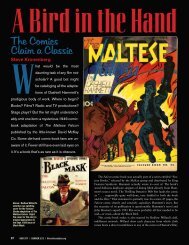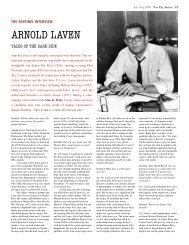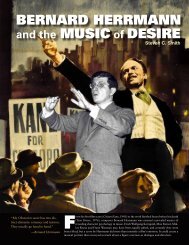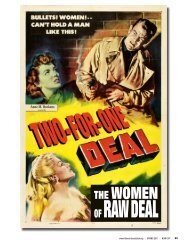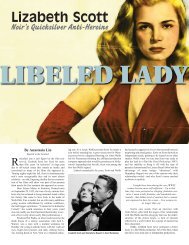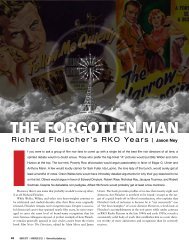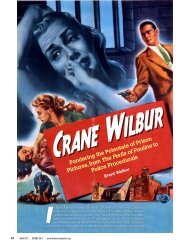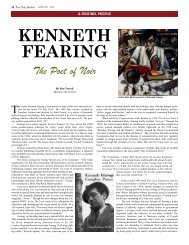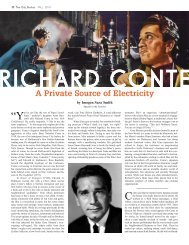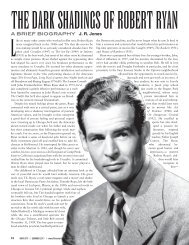The Many Deaths of Peggie Castle Jake Hinkson - Film Noir ...
The Many Deaths of Peggie Castle Jake Hinkson - Film Noir ...
The Many Deaths of Peggie Castle Jake Hinkson - Film Noir ...
You also want an ePaper? Increase the reach of your titles
YUMPU automatically turns print PDFs into web optimized ePapers that Google loves.
<strong>The</strong> <strong>Many</strong> <strong>Deaths</strong> <strong>of</strong> <strong>Peggie</strong> <strong>Castle</strong> <strong>Jake</strong> <strong>Hinkson</strong><br />
In Hollywood’s Golden Age, beauty was turned into a commodity, one found<br />
in abundance and renewed with each out-<strong>of</strong>-town bus. Thousands <strong>of</strong> lovely<br />
young women cycled through the system, had their physical attributes capitalized<br />
upon, and wound up back on the street with little more than the handful<br />
<strong>of</strong> cash it would take to get back home. Of these unlucky multitudes, few lived<br />
long enough to see themselves become a new kind <strong>of</strong> star: the rediscovered<br />
film noir icon, the object <strong>of</strong> scholarly study and geek adoration.<br />
42 NOIR CITY I SUMMER 2013 I filmnoirfoundation.org
Though a lot <strong>of</strong> actresses played the doomed bad girl, <strong>Peggie</strong> <strong>Castle</strong><br />
seemed to embody the ethos somehow. Something about her seemed<br />
dangerous—which is another way <strong>of</strong> saying, perhaps, that something<br />
about her threatened men. With her low, smoky voice and skeptical<br />
green eyes, she wasn’t hot, she was cool. She never seemed to lose control.<br />
Her sensuality always seemed to be hers to do with as she pleased,<br />
a tool to get what she wanted. If this was her innate quality as an actor,<br />
then she was made to suffer for it in film after film.<br />
That cool quality seemed to reflect the real woman as well. Welleducated<br />
and ambitious, she had a caustic wit about most things,<br />
and she evinced few romantic illusions about the business she’d chosen<br />
for herself. “<strong>The</strong> difference between an old fashioned kiss and a<br />
movie kiss,” she said once, “is about 1500 feet <strong>of</strong> film.”<br />
She lived a disconnected life from the beginning. Born Peggy (with<br />
a Y) Thomas Blair on December 22, 1927 in Appalachia, Virginia,<br />
she was the daughter <strong>of</strong> an industrial efficiency expert named Doyle<br />
Blair and his wife Elizabeth “Betty” Guntner. Doyle’s job kept the<br />
Blairs on the road with their only child. “<strong>The</strong> harder an efficiency<br />
expert works the sooner he’s out <strong>of</strong> a job,” she would later observe.<br />
“I attended 22 different schools while traveling from city to city with<br />
my father…so I’ve got a ‘home town’ story for dozens <strong>of</strong> reporters.”<br />
All scholarship and trivia aside, however, film noir is,<br />
in large part, a cult devoted to rescuing forgotten women<br />
from the obscurity that once seemed to be their final destiny.<br />
Because noir preserves these women primarily as symbols<br />
<strong>of</strong> sex, their onscreen legacy is lit with an especially erotic<br />
flame. This is certainly true <strong>of</strong> <strong>Peggie</strong> <strong>Castle</strong>, who came into<br />
the business as an 18-year old starlet, achieved moderate<br />
success as a femme fatale, and then found herself out <strong>of</strong><br />
work by the age <strong>of</strong> 35. As a result, the images we have <strong>of</strong><br />
her comprise a largely sexualized picture <strong>of</strong> a woman in her<br />
early twenties. What makes her legacy problematic, and<br />
fascinating, is the frequency with which this pretty picture<br />
is darkened by images <strong>of</strong> punishment and violence. Even<br />
in the fragile immortality granted by film, <strong>Peggie</strong> goes on<br />
dying, martyred again and again in misogynist fantasies <strong>of</strong><br />
eroticized sadism.<br />
You may not remember her. Most people don’t.<br />
She was never really a star, not even in the insular world<br />
<strong>of</strong> film noir, where she was usually cast as an easily disposable<br />
sex object. In her most famous scene, she was shot to<br />
death while doing a striptease. It was that kind <strong>of</strong> career.<br />
<strong>Castle</strong> retains a defiant dignity modeling a<br />
newspaper bikini (top left); the actress reflects<br />
a cool sensuality in another PR photo<br />
43 NOIR CITY I SUMMER 2013 I filmnoirfoundation.org
All this moving around seemed to give<br />
young Peggy a thoughtful, inward quality.<br />
Yet it was during this same period<br />
that the quiet girl found her love <strong>of</strong> the<br />
spotlight. While living in Pittsburgh as a<br />
child, she attended the Linden School in<br />
upscale Squirrel Hill where she studied<br />
French and ballet. At the age <strong>of</strong> eight, she<br />
danced and acted in a school play staged<br />
at the Pittsburgh Playhouse. She seemed<br />
to know, even then, that she wanted to<br />
be an actress.<br />
It must have felt like fate when the<br />
Blairs settled in Los Angeles around the<br />
time Peggy turned 14. She attended Hollywood<br />
High School and, lying about her<br />
age, got a job as a photographer’s model.<br />
After high school, she enrolled in the<br />
theater arts program at Mills College<br />
where she studied acting under Madaleine<br />
Mihaud, then a refugee from Europe.<br />
In 1945, still a few months shy <strong>of</strong> turning<br />
18, she married a 24-year old serviceman<br />
named Revis T. Call.<br />
It was to be the first <strong>of</strong> many name<br />
changes. Over the years, through various<br />
marriages and pr<strong>of</strong>essional rebrandings,<br />
in movie credits and news publications<br />
and government documents, she was listed<br />
under as many names as a CIA operative:<br />
Peggy T. Blair, Peggy Call, Peggy <strong>Castle</strong>, <strong>Peggie</strong> <strong>Castle</strong>, <strong>Peggie</strong> C.<br />
Blair, <strong>Peggie</strong> C. McGarry, <strong>Peggie</strong> S. Morgenstern. She once quipped<br />
that a name-dropper in Hollywood “is an actress who’s been married<br />
six times.”<br />
She did well in school but dropped out after only a year to work<br />
on the radio soap opera Today’s Children at $375 a week. Still, her<br />
time in school seems to have shaped her perceptions <strong>of</strong> the world.<br />
“<strong>The</strong> college girl has more tolerance [than the average girl],” she<br />
would explain once she’d become a working actress. For an actress<br />
who would spend much <strong>of</strong> her time playing morally dubious women,<br />
it was important to her not to judge her characters. Later in her career<br />
she would muse to a reporter, “Most <strong>of</strong> our suspicions <strong>of</strong> others<br />
are aroused by our knowledge <strong>of</strong> ourselves.”<br />
<strong>The</strong> account <strong>of</strong> her “discovery” by a talent scout while she<br />
ate lunch in Beverly Hills might well be one <strong>of</strong> those too-good-to-betrue<br />
Hollywood stories. She’d already been acting and modeling for<br />
years by 1947, when she made her debut, billed as Peggy Call, in the<br />
Adele Jergens comedy When A Girl’s Beautiful at Columbia.<br />
It is certain that her second film had a bigger impact on her career.<br />
Mr. Belvedere Goes To College (1949) was the sequel to the hit<br />
comedy Sitting Pretty (1948), with star Clifton Webb reprising his<br />
role as the wryly funny Lynn Belvedere. When Webb got snippy with<br />
Peggy on the set one day, Peggy—no one’s doormat despite being<br />
only an uncredited bit player on the picture—got snippy right back.<br />
<strong>The</strong> director liked the exchange so much it stayed in the picture and<br />
caught the eye <strong>of</strong> super-agent Charles Feldman. “I’ve always had a<br />
<strong>Peggie</strong> <strong>Castle</strong>, Shawn Smith, Mary Ellen Kay, and Dolores Donlon from <strong>The</strong> Long Wait<br />
44 NOIR CITY I SUMMER 2013 I filmnoirfoundation.org
temper as long as I can remember,” she later noted. “If I hadn’t had<br />
a temper, I might not have come to Mr. Feldman’s attention at all.”<br />
1950 was to be a big year for her. With Feldman’s help, she signed a<br />
seven-year contract with Universal and changed her screen name to <strong>Peggie</strong><br />
<strong>Castle</strong>. She also divorced Revis Call, bringing their brief marriage to<br />
a quick close. Not long after, she was linked to war hero-turned-movie<br />
star Audie Murphy. Finding herself in the tabloids only sharpened her<br />
sense <strong>of</strong> humor. “In Hollywood,” she sighed “gossip goes in one ear and<br />
out the mouth.”<br />
In those early days at Universal, she entered into the studio’s<br />
drama school under the tutelage <strong>of</strong> Universal’s acting coach, Sophie<br />
Rosenstein. Her classmates included up-and-comers like Rock Hudson,<br />
Peggy Dow, James Best, Ann Pearce, and Piper Laurie.<br />
She didn’t get along with one <strong>of</strong> her peers, ladies’ man Tony<br />
Curtis (who would later recall <strong>Peggie</strong> as “a girl I didn’t particularly<br />
like”), which led to an altercation between Curtis and Audie Murphy.<br />
Though he’d been widely celebrated as America’s most decorated<br />
enlisted man during World War II, Murphy suffered from a<br />
particularly rage-filled version <strong>of</strong> post-traumatic stress disorder. One<br />
day in the studio hallway he grabbed Curtis and growled, “<strong>Peggie</strong><br />
says you’ve been talking bad about her.”<br />
While Curtis calmed Murphy down that afternoon, <strong>Peggie</strong> decided<br />
the troubled war hero was too violent and called <strong>of</strong>f their relationship.<br />
“Audie is impossible to understand,” she told a friend. “You make every<br />
concession, then if you can’t help him, it’s better to say goodbye.”<br />
In a pattern that would repeat itself the rest <strong>of</strong> her life, she didn’t<br />
stay single long. Shortly, she started seeing one <strong>of</strong> the junior executives<br />
at Universal, Bob Rains. <strong>The</strong>y would elope in Juarez, Mexico in<br />
January the next year.<br />
For all <strong>of</strong> the initial excitement <strong>of</strong> landing the job at Universal,<br />
the work itself amounted to little more than bit roles. <strong>The</strong> year 1950<br />
was representative: a waitress in Crane Wilbur’s Outside the Wall,<br />
another waitress in the Ida Lupino vehicle Woman in Hiding, a telephone<br />
operator in I was a Shoplifter, a hat check girl in Shakedown.<br />
She did her best “playing the roles Yvonne De Carlo turned down”<br />
and hoped for better.<br />
More demeaning than the roles, however, were the endless scantily-clad<br />
publicity photos for which <strong>Peggie</strong> now found herself contractually<br />
obligated to pose. As the first signatory <strong>of</strong> Universal’s new<br />
“cheesecake clause” she got a lot <strong>of</strong> press, though not really the sort<br />
an aspiring actress wanted. A brief hue and cry arose when Shirley<br />
Temple, who was just a year younger than <strong>Peggie</strong>, denounced the<br />
new mandated photos—which the press built up as something <strong>of</strong> an<br />
attack on actresses like <strong>Castle</strong>. Asked for her comment, <strong>Peggie</strong> was<br />
characteristically blunt, explaining that for an up-and-comer it was<br />
a matter <strong>of</strong> economics: “A lot <strong>of</strong> gals who won’t pose for cheesecake<br />
won’t be eating cheesecake, either.”<br />
Still, the photos had their drawbacks. Perhaps an actress as beautiful<br />
as <strong>Peggie</strong> was always bound to be judged for her looks, but the<br />
“controversy” seemed to establish her as little more than a pretty girl<br />
in a swimsuit. “Soon enough I’ll be too old to be a starlet,” she said<br />
hopefully, “thank goodness.”<br />
Among her fellow actors in Rosenstein’s drama school, she held herself<br />
alo<strong>of</strong>. Years later, the actress Donna Martell would remember <strong>Peggie</strong><br />
as “a living doll and a beautiful girl” but she also sensed a deep sadness<br />
underneath <strong>Peggie</strong>’s beauty. “<strong>The</strong>re was something missing in that girl’s<br />
personality” Martell told writer Tom Weaver. “She was very lonely, and<br />
she was not a happy person. I felt that right away.”<br />
<strong>Peggie</strong>’s time at Universal seemed to slog on, with the roles getting<br />
a little bigger but no better. After a run <strong>of</strong> exotic princess-types<br />
in cheesy budget-epics like 1951’s <strong>The</strong> Prince Who Was A Thief and<br />
<strong>The</strong> Golden Horde, she complained to a reporter, “It’s good to get<br />
some clothes on again and not have to wiggle to the tune <strong>of</strong> a snake<br />
charmer’s pipe.”<br />
She was hopeful when the studio loaned her out to RKO for a<br />
45 NOIR CITY I SUMMER 2013 I filmnoirfoundation.org
A sultry <strong>Peggie</strong> <strong>Castle</strong> about to meet her fate in the first Mike Hammer film, I, the Jury<br />
small role in Payment on Demand (1951) with Bette Davis. It was<br />
an A-picture, at last, but after shooting had wrapped, studio head<br />
Howard Hughes demanded recuts and a tacked-on happy ending<br />
which pushed the release date back. By the time the film came out, it<br />
was overshadowed by Davis’s triumph in All About Eve (1950), and<br />
<strong>Peggie</strong> was already back on the Universal lot.<br />
If she wasn’t waiting around the studio for another nothing part,<br />
she was on the road doing thankless publicity tours. “All I did was<br />
travel 56,000 miles [promoting] four pictures I wasn’t in and had<br />
never seen,” she lamented <strong>of</strong> her time there. “It was embarrassing<br />
when people asked me what I thought <strong>of</strong> the pictures.”<br />
In 1952, her option with Universal expired and she and the studio<br />
parted ways. It was a bitter end to what had seemed, only a couple<br />
<strong>of</strong> years before, like a dream job. Echoing the sentiments <strong>of</strong> many<br />
talented B-listers, she wondered aloud why the studio never found a<br />
place for her. “I used to watch wonderful parts go to outsiders while<br />
a lot <strong>of</strong> us gathered dust,” she remarked later. “It seems odd that so<br />
many <strong>of</strong> the studios keep their young<br />
talent in the deep freeze instead <strong>of</strong><br />
turning them out early…I wish I could<br />
figure it all out.”<br />
At the smaller studios and independent<br />
production companies, <strong>Peggie</strong><br />
moved up to lead roles, though<br />
the pictures were <strong>of</strong> dubious quality:<br />
the Monogram western Wagons West<br />
(1952), Columbia’s redbaiter Invasion<br />
USA (1952), Allied Artists’ Cow<br />
Country (1953) with Edmond O’Brien.<br />
Her career seemed stuck.<br />
<strong>The</strong>n her savior arrived in the<br />
unlikely form <strong>of</strong> Mickey Spillane. <strong>The</strong><br />
pulp writer cum publishing phenomenon<br />
had launched his Mike Hammer<br />
series in 1947 and kicked <strong>of</strong>f a juggernaut<br />
<strong>of</strong> sex, violence, and astronomical sales that reconfigured the<br />
literary landscape. It was only a matter <strong>of</strong> time before his grisly vision<br />
found its way to the screen. Spillane talked <strong>of</strong> starting his own<br />
studio and teaching the Hollywood sissies a thing or two about the<br />
movie business (“I told him,” <strong>Peggie</strong> recalled, “‘I hope you have lots<br />
<strong>of</strong> money.’ And he said, ‘I have two million!’”). In the meantime, the<br />
rights to his works were snapped up by producer Victor Saville.<br />
Saville’s first film was an adaptation <strong>of</strong> the debut Hammer novel<br />
I, the Jury (1953). In the lead role he cast a little known television<br />
actor named Biff Elliot, and as the film’s villain, the sexy psychologist<br />
Charlotte Manning, he picked <strong>Peggie</strong>.<br />
With her usual biting wit, she summed up the macho Spillane: “If<br />
you saw a picture <strong>of</strong> three guys, he’d be the little guy in the middle.”<br />
She did acknowledge that playing the female lead in a Mike Hammer<br />
movie would at least get her recognized. “You seldom become<br />
famous playing good girls. I appeared in 20 pictures, mostly as a<br />
wide-eyed ingénue and nobody ever heard <strong>of</strong> me. <strong>The</strong>n I did I, the<br />
46 NOIR CITY I SUMMER 2013 I filmnoirfoundation.org
Jury. It wasn’t exactly the greatest picture ever made. But now people<br />
know who I am.”<br />
<strong>The</strong> movie begins with a pre-credits murder and then Mike Hammer<br />
shows up to swear bloody revenge (the ur-plot <strong>of</strong> the entire<br />
Hammer canon). <strong>The</strong> story consists <strong>of</strong> Hammer going from one<br />
place to the next grilling potential suspects. His interactions with<br />
men invariably end in violence, while his interactions with women<br />
invariably end in sexual innuendo. At the end, he suddenly figures<br />
out Manning is the killer and carries out the execution.<br />
<strong>The</strong> film’s big selling point, aside from the gimmick <strong>of</strong> being a<br />
3-D crime flick, was the showdown between Hammer and Manning.<br />
At the end <strong>of</strong> Spillane’s novel, she strips naked in an unsuccessful<br />
attempt to dissuade Hammer from carrying out his execution. <strong>The</strong><br />
poster for the film featured a graphic <strong>of</strong> <strong>Peggie</strong> unbuttoning her<br />
blouse—which seemed to promise the notorious striptease but, <strong>of</strong><br />
course, the film itself had to work purely through innuendo. <strong>Peggie</strong><br />
slips <strong>of</strong>f only her rain coat and her shoes before Hammer guns<br />
her down. Her last words are, “How could you?” To which he<br />
replies, “It was easy.”<br />
What’s notable here is that <strong>Peggie</strong> gives, pretty much by<br />
unanimous agreement, the best performance in the film.<br />
Whereas Biff Elliot’s strained portrayal <strong>of</strong> Hammer consists<br />
mostly <strong>of</strong> petulant barks, <strong>Peggie</strong> has the exact combination <strong>of</strong><br />
alo<strong>of</strong> beauty and devious intelligence that her role calls for, and<br />
one wonders what she might have done opposite a decent actor<br />
in the lead role. Her final scene in the film might be a distinctly<br />
puritanical form <strong>of</strong> misogynist fantasy—male stoicism obliterating<br />
the threat posed by female sexuality—but <strong>Peggie</strong>’s mesmerizing<br />
in it. Captured in John Alton’s shimmering black and<br />
white cinematography, with Franz Waxman’s sultry jazz score<br />
pushing us toward the bedroom, <strong>Peggie</strong>’s palpable sensuality is<br />
the driving force in one <strong>of</strong> the most sexual scenes in classic noir.<br />
That same year, she made her best film noir, Phil Karlson’s<br />
99 River Street, where she plays Pauline Driscoll, the cheating<br />
wife <strong>of</strong> ex-boxer turned cabbie Ernie Driscoll (John Payne). At<br />
the beginning <strong>of</strong> the film, she leaves Ernie for a hood named<br />
Victor Rawlins, played by cold-eyed Brad Dexter. This initiates<br />
a long dark night <strong>of</strong> the soul for Ernie, who crisscrosses<br />
nighttime New York City, dodging cops and gangsters, while<br />
he mends his broken heart with a chipper actress named Linda<br />
(Evelyn Keyes).<br />
<strong>Noir</strong> doesn’t get any better than 99 River Street. It’s marvelously<br />
acted and shot, and the cast is uniformly excellent. Payne<br />
was never better as a leading man, and Keyes is almost stunningly<br />
good, rocking her two big scenes (one recounting a murder<br />
and one seducing Dexter) like she’s auditioning for greatness.<br />
One can argue, however, that it is <strong>Peggie</strong> <strong>Castle</strong>’s performance<br />
<strong>Peggie</strong> <strong>Castle</strong>’s Charlotte Manning <strong>of</strong>fers Biff Elliot's Mike Hammer some<br />
refreshment in her breakthrough film, I, the Jury<br />
47 NOIR CITY I SUMMER 2013 I filmnoirfoundation.org
the Jury her murder here has the effect <strong>of</strong> punishing her character in<br />
a sexualized manner. This, both films seemed to be saying, is what<br />
happens to bad girls. This message is suffused with a deep sexism, <strong>of</strong><br />
course, but it also contains the integral ingredients <strong>of</strong> noir: transgression<br />
and ruin.<br />
Consider something else. At the end <strong>of</strong> 99 River Street, we find<br />
that good girl Linda has abandoned her lifelong dreams <strong>of</strong> being a<br />
Broadway actress so she can have babies and man the front desk<br />
at Ernie’s filling station. Thus, Linda gets a happy ending complete<br />
with the socially sanctioned dreams <strong>of</strong> motherhood and middle-class<br />
prosperity. Pauline, on the other hand, is destroyed because her dissatisfaction<br />
with her marriage and her attraction to a l’homme fatale<br />
lead to her downfall. Though Pauline is discarded at the end, it is her<br />
story and <strong>Castle</strong>’s haunting performance that give 99 River Street its<br />
true noir heart.<br />
<strong>Peggie</strong> <strong>Castle</strong> with John Payne in her best film, 99 River Street<br />
that ultimately makes 99 River Street fascinating because it hints at a<br />
counter-narrative which complicates the main story. <strong>Peggie</strong> doesn’t<br />
play Pauline as a type, as the rotten wife wooing her man to his doom<br />
for the sheer hell <strong>of</strong> it. Pauline seems truly disappointed in her life<br />
with Ernie. When she asks him to turn <strong>of</strong>f a television rebroadcast <strong>of</strong><br />
his last losing bout, she does it with a note <strong>of</strong> pained weariness. <strong>The</strong>ir<br />
marriage is an old story: she married him on the way up when the<br />
future seemed full <strong>of</strong> parties and fur coats, but now that he’s driving<br />
a cab, she feels like she made a mistake. She’s not thrilled by Ernie’s<br />
promises that maybe one day they’ll be able to open a filling station.<br />
Well, hell, who can blame her?<br />
Something else is troubling, something never explicitly stated in<br />
the film, but which, upon repeated viewings, becomes unmistakable:<br />
Pauline is terrified <strong>of</strong> her husband. After Ernie finds out that she’s been<br />
cheating on him, she trembles as she tells Dexter, “He’ll kill me. You<br />
don’t know what he’s like. He broods about things, and suddenly he<br />
explodes.” Take Pauline’s fear along with the fact that Ernie twice gets<br />
physical with nice girl Linda—lifting his hand to strike her in one scene<br />
and shoving her across a room in another—and it becomes clear that<br />
the Driscoll marriage isn’t the simple story <strong>of</strong> a sweet guy and a rotten<br />
dame. Like all great femme fatales, Pauline has her reasons.<br />
Our sympathy for Pauline only increases as her attempt to escape<br />
her marriage goes horribly wrong. Victor turns out to be very bad<br />
news indeed. He takes her to meet the fence for some stolen jewels<br />
(Jay Adler) and then lets a thug (Jack Lambert) slap her around.<br />
When Adler calls <strong>of</strong>f the deal for the jewels because <strong>of</strong> Pauline’s<br />
presence (“I don’t do business with women!”) Victor makes a coldblooded<br />
business decision. He takes Pauline back to his apartment,<br />
kissing her while he tightens a scarf around her throat. As the camera<br />
moves past her face to his, she purrs “Victor, don’t…” <strong>The</strong> next<br />
time we see her, she’s been strangled and left in Ernie’s cab.<br />
In a disturbing trend, this marked the second time <strong>Peggie</strong> was<br />
murdered in an eroticized way in a film noir. As with her death in I,<br />
By this point she was known primarily for playing the bad<br />
girls in crime pictures. Putting a good face on it, <strong>Peggie</strong> asked a reporter,<br />
“Well, doesn’t every girl want to be a femme fatale?”<br />
Sometimes, though, she admitted that being the bad girl had one redundant<br />
aspect. “I have yet to live through a picture,” she joked in an<br />
interview. “<strong>The</strong>re I am on the set reading the script, feeling just wonderful.<br />
I’m going to come out alive for a change. <strong>The</strong>n I turn the page and<br />
three bullet holes appear in my back. <strong>Peggie</strong> <strong>Castle</strong> bites the dust again.”<br />
What an odd thing, dying for a living. “I’ve been shot, knifed,<br />
clubbed, strangled, poisoned and hanged. I’m beginning to feel like<br />
48 NOIR CITY I SUMMER 2013 I filmnoirfoundation.org
the girl everybody hates.”<br />
What was it about her that<br />
made her, as one headline put it<br />
“<strong>The</strong> Girl <strong>The</strong>y Love To Kill”?<br />
Was it the cool reserve, the green<br />
eyes that always seemed to be<br />
doing some inner calculations?<br />
Tall, voluptuous, and palpably<br />
intelligent—everything about her<br />
read as strength. In westerns, she<br />
was a surprisingly violent leading<br />
lady, <strong>of</strong>ten butched up in<br />
pants and six-shooters with ad<br />
copy like “No Man Could Tame<br />
Her!” <strong>The</strong> bitter irony, <strong>of</strong> course,<br />
was that she was forever being<br />
tamed, usually by force.<br />
Her next noir utilized her<br />
dangerous vixen reputation to<br />
a different end. <strong>The</strong> Long Wait<br />
(1954) was another Spillane<br />
adaptation, though it wasn’t a<br />
Hammer story. <strong>The</strong> movie stars<br />
Anthony Quinn as a tough amnesia<br />
victim named Johnny Mc-<br />
Bride who discovers that he’s<br />
wanted for murder. He sets out<br />
to clear his name and the film<br />
follows the usual amnesia plot<br />
pretty much to the letter. Mc-<br />
Bride comes into contact with<br />
people who know more about<br />
him than he knows about himself—including<br />
the cops who<br />
want to bust him for murder, the<br />
crooks who seem to be after<br />
him for secret reasons,<br />
and a parade <strong>of</strong> beautiful<br />
women, one <strong>of</strong> whom may<br />
or may not hold the key to<br />
the mystery <strong>of</strong> McBride’s<br />
past.<br />
<strong>The</strong> film was again<br />
produced by Victor Saville,<br />
who also directed—<br />
and his direction is rather<br />
lacking, particularly in<br />
the performance that<br />
he gets out <strong>of</strong> his leading<br />
man. Anthony Quinn<br />
could be a dynamic performer<br />
in the right role,<br />
but here he mostly seems<br />
like a grumpy lunkhead.<br />
He kisses every woman in<br />
the picture like he’s trying<br />
to wring information out<br />
<strong>of</strong> her face. <strong>The</strong>re’s not a<br />
<strong>Peggie</strong> <strong>Castle</strong> sidles up to perpetually grouchy Anthony Quinn in her second Mickey Spillane outing,<br />
<strong>The</strong> Long Wait<br />
single moment <strong>of</strong> genuine eroticism,<br />
and no one has any chemistry<br />
with anyone else, which<br />
might be the effect <strong>of</strong> Saville’s<br />
particularly awkward reverse<br />
shots.<br />
<strong>The</strong> picture has redeeming<br />
features, though, and chief<br />
among them is <strong>Peggie</strong>. Though<br />
her role is little more than a sexy<br />
red herring—turns out she’s not<br />
the mystery woman with all the<br />
answers—she’s still the most<br />
dynamic performer in the film.<br />
With her shimmering blonde<br />
locks and her air <strong>of</strong> quiet mystery,<br />
she handily gives the best<br />
performance in the movie, and<br />
every time she shows up on<br />
screen, <strong>The</strong> Long Wait perks up.<br />
She also features in the film’s<br />
strangest—and best—scene: an<br />
almost impressionistic little<br />
number in which <strong>Castle</strong> and<br />
Quinn are kidnapped by a gangster<br />
and taken to an abandoned<br />
warehouse. In the middle <strong>of</strong> a<br />
huge pool <strong>of</strong> white light, bordered<br />
by complete darkness,<br />
Quinn is tied to a chair and <strong>Castle</strong><br />
is bound-up on the floor. In a<br />
montage <strong>of</strong> askew camera angles<br />
that stands out stylistically from<br />
the rest <strong>of</strong> the film, <strong>Castle</strong> crawls<br />
over to Quinn as the psychotic<br />
gangster throws obstacles<br />
in her path.<br />
<strong>The</strong> scene was designed<br />
by the great art director<br />
Boris Leven, who drew a<br />
series <strong>of</strong> sketches for the<br />
director. Saville recalled<br />
using 87 different set-ups<br />
to match Leven’s drawings,<br />
shot for shot. It’s the<br />
big set-piece <strong>of</strong> the film,<br />
the one scene that everyone<br />
remembers. It also has<br />
the added benefit <strong>of</strong> summing<br />
up <strong>Peggie</strong> <strong>Castle</strong>’s<br />
essential position in noir—<br />
bound and crawling across<br />
a floor, tortured by a man.<br />
<strong>The</strong> sequence ends<br />
with <strong>Peggie</strong> retrieving a<br />
hidden gun, shooting the<br />
gangster, and getting shot<br />
in return. For once, she<br />
49 NOIR CITY I SUMMER 2013 I filmnoirfoundation.org
lives, but although she takes a bullet for the hero, she still doesn’t<br />
wind up with him in the end. Another dame gets him. <strong>Peggie</strong> gets a<br />
ride to the hospital.<br />
“That’s right,” she says with a s<strong>of</strong>t smile. “Who isn’t?”<br />
<strong>The</strong> best thing about the movie is the relationship between Gladys<br />
and Casey. <strong>The</strong>ir scenes together have a deep, natural chemistry. Part<br />
<strong>of</strong> what made <strong>Castle</strong> an interesting actor is that, although she had a<br />
beautifully expressive face, her impulse was always toward restraint.<br />
Lovejoy, one <strong>of</strong> the great unsung actors <strong>of</strong> the fifties, similarly<br />
held himself in check. Together they do a subtle duet, moving haltingly,<br />
cautiously toward love.<br />
Here <strong>Peggie</strong>, at the end <strong>of</strong> her noir career, plays a slightly older,<br />
more roughed up version <strong>of</strong> her usual vixen role. Gladys, a past-herprime<br />
beauty who’s had some hard breaks, fears she may be coming<br />
to the end <strong>of</strong> things. <strong>Peggie</strong> still looks stunning, but at only 28 she<br />
can already do world-weariness like she means it. When he asks her<br />
“Where’d you get that halo all the sudden?” she just chuckles and<br />
says “Me? That’s funny.”<br />
Unfortunately, Gladys doesn’t make it to the end <strong>of</strong> the picture. Her<br />
time runs out when Becker’s psycho henchman, played by Timothy Carey,<br />
decides to kill her.<br />
We don’t see <strong>Peggie</strong>’s demise. In her last scene, she simply says<br />
goodbye to Lovejoy. <strong>The</strong>n she crosses Hope Street and disappears<br />
into the night.<br />
With Finger Man she closed out her noir career—and with it, the<br />
roles that somehow best suited her. She found herself in increasingly<br />
inferior material. Something like the western Two-Gun Lady (1955)<br />
(“Every Man Was Her Target!”) assembles a great cast including <strong>Peggie</strong>,<br />
Marie Windsor, and William Talman, and then wastes them in a<br />
shoddily produced mess <strong>of</strong> boring exposition and sloppy action. “It<br />
was lightweight,” Marie Windsor later judged, “and done in a hurry!”<br />
<strong>Peggie</strong> kept working: supporting Randolph Scott and Dorothy<br />
Malone in the western Tall Man Riding (1955); starring opposite<br />
Richard Conte in Target Zero (1955); headlining a no-budget western<br />
called <strong>The</strong> Oklahoma Woman (1956), one <strong>of</strong> the first productions<br />
<strong>of</strong> the young Roger Corman. In 1957, she headed to England<br />
to star opposite Zachary Scott in the tepid Anglo Amalgamated production<br />
<strong>The</strong> Counterfeit Plan—one <strong>of</strong> those transcontinental crime<br />
pictures that <strong>of</strong>ten signaled the death knell <strong>of</strong> a fading Hollywood<br />
career in the late 1950s.<br />
For better and for worse, her screen image as the sexybut-suspect<br />
woman <strong>of</strong> the world was set. To an extent, she accepted<br />
this fate. “Let’s face it,” she said. “Nobody likes nice<br />
women on the screen. Nice women are dull.”<br />
But there were other things she would have liked to have done.<br />
Given her quick wit, it’s a pity no one ever put her in a comedy,<br />
something she longed for. “Not the slapstick type,” she said “but<br />
the kind <strong>of</strong> comedy that Carole Lombard used to do. I think I could<br />
do very well in that sort <strong>of</strong> role, the tongue-in-cheek kind.”<br />
<strong>The</strong> comedy roles never came, though.<br />
In 1955, she gave perhaps her most nuanced noir performance<br />
in Harold Schuster’s Finger Man. Frank Lovejoy plays a<br />
hood named Casey Martin, who at the behest <strong>of</strong> the feds, is trying<br />
to infiltrate a gang led by Dutch Becker (Forrest Tucker). He<br />
enlists the help <strong>of</strong> a reformed prostitute named Gladys, played<br />
by <strong>Castle</strong>. As she helps him work his way into the gangster’s<br />
good graces, Gladys and Casey fall in love.<br />
“You’re two people aren’t you, Casey?” she asks him.<br />
“Who isn’t?” he replies.<br />
Left to right: Forrest Tucker, Frank Lovejoy, and <strong>Peggie</strong> <strong>Castle</strong> in her most nuanced role:<br />
Harold Schuster's Finger Man<br />
50 NOIR CITY I SUMMER 2013 I filmnoirfoundation.org
That same year she had a good role in an interesting<br />
horror film, Back from the Dead, written<br />
by the novelist and screenwriter Catherine<br />
Turney. <strong>Peggie</strong> plays a woman possessed by the<br />
ghost <strong>of</strong> her husband’s first wife, an evil spirit<br />
who has returned from the dead to rejoin a Satanic<br />
cult leader. Part Rebecca and part Rosemary’s<br />
Baby, the small production paired <strong>Peggie</strong><br />
with the talented (but blacklisted) Marsha Hunt<br />
and gave her some juicy scenes to play, including<br />
a sequence where she gasses Hunt and takes<br />
a scythe to her dog. Her co-star was impressed<br />
with both <strong>Peggie</strong> and her performance in the<br />
film. “I had not known her or even her name<br />
prior to that,” Hunt later recalled. “But she was<br />
pr<strong>of</strong>essional and very good.”<br />
Back from the Dead might have been the highlight<br />
<strong>of</strong> 1957 but <strong>Peggie</strong> also hit her career nadir<br />
that year in the aptly titled Beginning <strong>of</strong> the End,<br />
a bargain-budget creature feature that found her<br />
teaming up with Peter Graves to fight giant killer<br />
grasshoppers. Graves remembered her as “a wonderful<br />
actress” who “always looked appealing” no<br />
Don Hagerty and Arthur Franz restrain a raging, possessed <strong>Peggie</strong> <strong>Castle</strong> from knifing Marsha Hunt in the<br />
effective Back from the Dead<br />
51 NOIR CITY I SUMMER 2013 I filmnoirfoundation.org
matter what, but viewers are more likely to<br />
notice that she looks bored in a movie that<br />
could only signal the demise <strong>of</strong> her career in<br />
features.<br />
She had already started doing more<br />
and more television. This transition, <strong>of</strong> course,<br />
happened to the entire generation <strong>of</strong> second-tier<br />
stars in the fifties. As the B-movie market dried<br />
up (due to the decrease in studio output and the<br />
dissolution <strong>of</strong> the double feature), television work<br />
expanded. It was a living, but like many others,<br />
<strong>Peggie</strong> saw it as a step down.<br />
“I hate television,” she announced with her<br />
usual bluntness. “I don’t like to watch it and I<br />
don’t like to act in it. <strong>The</strong>y make those half-hour<br />
shows so fast, you can’t possibly do a good acting<br />
job. And they pay you shoe buttons.”<br />
But once the giant grasshoppers eat what’s<br />
left <strong>of</strong> your movie career, what’s a gal to do?<br />
Befitting someone with noir cred, she did<br />
plenty <strong>of</strong> crime show work. She played the<br />
murder suspect in “<strong>The</strong> Case <strong>of</strong> the Negligent<br />
Nymph,” an episode <strong>of</strong> Perry Mason. On a<br />
77 Sunset Strip episode called “<strong>The</strong> Well-<br />
Selected Frame,” she played a woman convinced that her husband<br />
is trying to kill her. And she waded back into Spillane territory one<br />
last time for an episode <strong>of</strong> Mike Hammer called “<strong>The</strong> Big Drop,” in<br />
which she hires Hammer to find the man who killed her father.<br />
Her longest gig in television, and very nearly her last, was for the<br />
western series Lawman. At first, she turned down the role <strong>of</strong> Lily Merrill.<br />
“<strong>The</strong>y wanted me to be a regular on the series,” she said, “but they<br />
wanted me to run the local café. I had a vision <strong>of</strong> myself serving c<strong>of</strong>fee in<br />
an apron for 38 weeks so I said no.” Besides, she had never bought into<br />
the mythos <strong>of</strong> the western. She suspected, she once said, that “the strange<br />
irresistible force which<br />
drives some men out into<br />
the wilderness is known<br />
as house cleaning.”<br />
Anyway, the job<br />
came with a hitch. <strong>The</strong>y<br />
wanted her to sing. “I’d<br />
never sung in my life,”<br />
she told reporters. “Not<br />
even in the bathtub.”<br />
But in the end, the<br />
job was steady work in<br />
the most popular genre<br />
<strong>of</strong> the day. <strong>The</strong> show’s<br />
producers changed her<br />
character to a saloon<br />
owner and hired a voice<br />
coach to get her in shape<br />
for the singing. When<br />
they floated the idea<br />
<strong>of</strong> putting together a<br />
record, <strong>Peggie</strong> joked,<br />
“Well, I don’t have the<br />
greatest voice in the world. Maybe I can<br />
record an album titled ‘Songs To Groom<br />
Horses By.’”<br />
Unfortunately, Lawman itself was<br />
little more than a poor man’s Gunsmoke<br />
starring stone-faced John Russell. <strong>The</strong><br />
series added <strong>Peggie</strong> at the start <strong>of</strong> the<br />
second season to be a spunkier, sassier<br />
version <strong>of</strong> Miss Kitty (one headline read<br />
“Blonde Comes to Laramie to Defrost<br />
TV’s Lawman”), but while she quickly<br />
became one <strong>of</strong> the best things about the<br />
show, the show itself remained a fairly<br />
pedestrian oater.<br />
During her run on the program,<br />
<strong>Peggie</strong> started drinking more heavily.<br />
She still looked good, but the old sheen<br />
had disappeared. When Lawman surrendered<br />
its badge after three more seasons,<br />
<strong>Peggie</strong> decided she’d had enough and effectively<br />
retired from acting.<br />
She had divorced second husband<br />
Bob Rains back in 1954, claiming cruelty<br />
and general boorishness. A few months<br />
later she married assistant director William McGarry, who was twenty-two<br />
years her senior. “At least I’m glad I didn’t marry an actor,”<br />
she said. “That’s one form <strong>of</strong> insanity I didn’t indulge.” In 1963, the<br />
year after Lawman was cancelled, she and McGarry had a daughter<br />
named Erin.<br />
<strong>The</strong>ir marriage outlived her career (she notched a final television<br />
appearance on an episode <strong>of</strong> <strong>The</strong> Virginian in 1966), but in 1970 she<br />
and McGarry divorced. Writer David J. Hogan reports that <strong>Castle</strong>’s<br />
drinking had developed into a full-blown crisis by this time, hastening<br />
the end <strong>of</strong> her third marriage. “Her appearance changed for the<br />
worse,” Hogan wrote<br />
in “Green Eyes Crying”<br />
a 1992 article about<br />
<strong>Castle</strong> “and she gradually<br />
slipped away from<br />
reality. Her situation<br />
was made worse by increasingly<br />
unhappy relationships<br />
with her father<br />
and daughter.”<br />
After her divorce<br />
from McGarry, she<br />
moved into a two-room<br />
apartment over a garage<br />
in East Hollywood. She<br />
stayed inside for days on<br />
end, drinking alone and<br />
listening to records. Just<br />
before Christmas, the<br />
landlord went to check<br />
on her. She answered<br />
the door in tears. When<br />
he inquired what was<br />
52 NOIR CITY I SUMMER 2013 I filmnoirfoundation.org
A smiling <strong>Peggie</strong> <strong>Castle</strong> is flanked by John Russell<br />
(left) and Peter Brown in this publicity still for the TV<br />
oater Lawman<br />
wrong, she told him, “Today’s my birthday. Nobody remembered.”<br />
<strong>The</strong> model and actor turned Hollywood oral chronicler William<br />
Ramage was friends with <strong>Peggie</strong>’s landlord at the time and later recalled<br />
his stories about the famous guest above the garage:<br />
“She only left her apartment to buy groceries, Rainier Ale malt liquor,<br />
and gallon jugs <strong>of</strong> Almaden<br />
Chablis. Her car was a Ford convertible<br />
which was about twelve<br />
years old and in poor condition.<br />
Since the battery on the car<br />
was frequently dead, Lee, the<br />
landlord, had to use his jumper<br />
cables to help her get it started.<br />
Her speech was rarely slurred,<br />
but when she was drinking the<br />
malt liquor her language would<br />
turn pr<strong>of</strong>ane and vulgar. Lee was<br />
afraid she would fall down the<br />
stairs drunk someday, so at the<br />
end <strong>of</strong> the six month lease, he<br />
asked her to move.”<br />
Not long after her move she<br />
met and married a businessman<br />
named Arthur Morgenstern in<br />
October <strong>of</strong> 1970, but the hasty<br />
fourth marriage did little to stop<br />
<strong>Peggie</strong>’s alcoholic descent. In<br />
1973, two events unraveled what<br />
was left <strong>of</strong> her life. On February<br />
17, her mother, Betty, died. <strong>The</strong>n,<br />
just two months later, Morgenstern<br />
suddenly died.<br />
<strong>Peggie</strong> plummeted into alcoholic<br />
despair. In a final attempt to<br />
save herself, that summer she checked into<br />
the Camarillo State Hospital. When she got<br />
out, however, she went back to drinking. She<br />
holed up by herself in a cheap room at the<br />
Hollywood Hawaiian Hotel and Apartments,<br />
just up the hill from Hollywood Boulevard<br />
where her star on the Walk Of Fame lay all<br />
but forgotten.<br />
On the night <strong>of</strong> Friday, August 10, William<br />
McGarry, worried about <strong>Peggie</strong>, went<br />
to check on her. He found her sitting on the<br />
couch in her living room, dead. Authorities<br />
said she’d been drinking just before her death.<br />
An autopsy revealed what anyone could have<br />
guessed: cirrhosis. She was 45.<br />
<strong>The</strong> next day, her passing rated a perfunctory<br />
write-up in the newspapers. Most<br />
mentioned Lawman and the grasshopper<br />
movie. <strong>The</strong>y all mentioned the drinking<br />
and the divorces. <strong>The</strong>y couldn’t agree on<br />
the spelling <strong>of</strong> her name.<br />
Hardly any <strong>of</strong> the obituaries recalled the noirs. Yet it is those<br />
films which have lasted; and, as rough a time as she got in them—perhaps<br />
because she got such a rough time in them—it seems only fitting<br />
that the noirs should be the ones to safeguard her memory.<br />
After all, to save a film is to save<br />
images haunted by the mystery <strong>of</strong><br />
brief, ineffable human lives. <strong>The</strong><br />
film doesn’t have to be an artistic<br />
masterpiece, either. It can be a<br />
cheap little B-movie, something<br />
like Finger Man, where <strong>Peggie</strong><br />
plays a tragic ex-bad girl attempting<br />
to redeem herself. If you know<br />
her other films, and if you feel the<br />
weight <strong>of</strong> her real life behind them,<br />
then one scene in the film takes<br />
on a particular resonance. She has<br />
a short monologue in which she<br />
explains herself to Frank Lovejoy.<br />
As her eyes well with tears, <strong>Peggie</strong><br />
beautifully delivers this, her noir<br />
epitaph:<br />
“All my life, I’ve had dreams.<br />
Not big ones, just my share <strong>of</strong> the<br />
little things—that someone would<br />
like me, really like me, maybe even<br />
respect me…I know I’m no bargain.<br />
I’ve been around, plenty. I<br />
don’t feel sorry for myself. Only,<br />
sometimes, I get the feeling there<br />
isn’t any more time, like there isn’t<br />
going to be any tomorrow. Be nice<br />
to me. Please.” ■<br />
53 NOIR CITY I SUMMER 2013 I filmnoirfoundation.org



